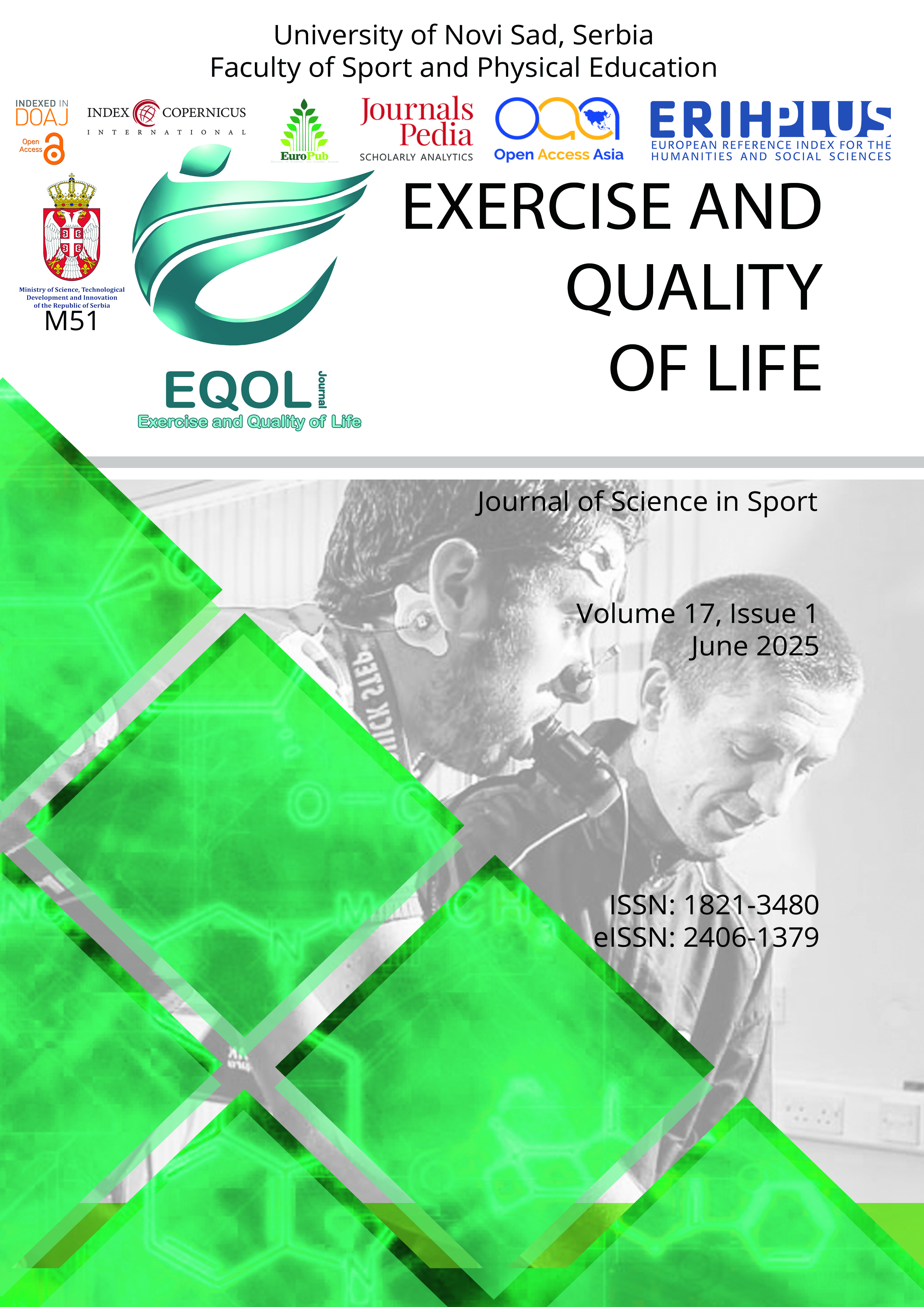Current issue

Volume 17, Issue 1, 2025
Online ISSN: 2406-1379
ISSN: 1821-3480
Volume 17 , Issue 1, (2025)
Published: 15.06.2025.
Open Access
All issues
Contents
15.06.2021.
Original scientific paper
Somatotypes and handgrip strength analysis of elite Serbian sambo athletes
The aim of this study was to establish whether there are differences between weight categories in different anthropometric measurements and handgrip strength between elite Serbian male and female sambo athletes divided into weight categories. A total of 70 elite Serbian sambo athletes participated in the study, who were participants of the World Cadet Sambo Championship held in Novi Sad. Athletes are classified into categories according to gender and official weight categories. Using anthropometry, we calculated somatotypes and hand-grip strength. For statistical analysis, we used a one-way analysis of variance and Tukey’s post hoc tests to compare group differences by weight categories. Somatotype analysis shows that a typical somatotype in male sambo athletes was endomorphic mesomorphs. In female groups, the most common somatotype in the lightest categories was mesomorphic ectomorphs, and in the heaviest categories were endomorphic mesomorphs. Examining the handgrip for both left and right hand, as well as in total, shows that there is a statistically significant difference between the categories. In total, the strength of the handgrip increases progressively in groups. In male categories, the difference exists between the first 4 groups and -78kg, as well as between -42kg and -46kg and the heaviest weight category. Differences between weight categories in female athletes were found between the lightest group and last six groups in total, in favor of the last six. Anthropometric measurements revealed a statistically significant difference between weight categories. Mesomorphy was the most dominant somatotype in male categories, while female athletes differed concerning weight category. The achieved results can serve as data to compare the somatotype and handgrip strength of elite sambo athletes on a national and international level. These findings suggest that the handgrip strength and somatotypes are the keys to success in relation to the weight category.
Jelena Slankamenac, Tatjana Trivić, Damjan Jakšić, Miodrag Drapšin, Nemanja Lakićević, Patrik Drid
15.12.2019.
Original scientific paper
Isokinetic performance of shoulder external and internal rotators in judo and karate female elite athletes
The aim of this study was to determine the isokinetic profile of shoulder internal and external rotators in judo and karate female elite athletes.; Methods: Study sample consisted of senior 13 female karate athletes (21.23 ± 2.83 years) and 13 female judokas (21.00 ± 2.51 years). For testing the isokinetic muscle strength of the external and internal rotation of the shoulder joint, the HUMAN NORM isokinetic dynamometer has been used. Testing the maximum muscle strength of subjects was carried out at an angular speed of 60º / sec and 180 º / sec; Results: Judo female athletes had higher isokinetic peak torque for right and left shoulder internal rotators than karate athletes at 60º/s and 180º/s, with a large effect size, Cohen’s d = 0.89, 1.02, 0.97, 0.95, respectively. Also, large differences were observed between the judo and karate subjects in peak muscle torques of the right shoulder external shoulder rotator muscles of both limbs were greater in judokas than karate athletes. Isokinetic testing should be an integral part of training process in combat sports because in order to decrease the number of injuries and improve performance.
Miodrag Drapšin, Nebojša Trajković, Dragan Atanasov, Danilo Radanović, Milka Imbronjev, Roberto Roklicer, Dejan Madić, Nebojša Maksimović, Vuk Raonić, Tatjana Trivić, Patrik Drid
02.12.2011.
Original scientific paper
BODY MASS INDEX AND BODY FAT CONTENT IN ELITE ATHLETES
The aim of this study was to evaluate body fat content (BF) of elite athletes obtained by two different field methods for body composition measurements and to compare it with body mass index (BMI) values. The research was conducted on 40 male athletes (20 runners and 20 handball players) and 30 non athletes. BF was calculated from the skinfold values (BFsft) and estimated using a hand-held impedance analyzer (BFbia%). Body mass index, waist to hip ratio (WHR) and waist to stature ratio (WSR) were calculated from adequate anthropometric values. Comparing the BF content between non athletes and two different sport groups, significant difference was found in all parameters between runners and non athletes (p < 0.05). Significant difference was found between BF values of runners and handball players (p < 0.05). Runners have had significantly lower BF, estimated by both methods. They also have had significantly lower WHR and WSR (p < 0.05). In the group of athletes and non athletes with BMI higher than 25 kg/m 2 , or lower than 20 kg/m 2 , comparing with others, no significant difference was found in BFsft and WHR. BMI is not a good predictor of BF, because it does not provide specific information about body fatness, but rather body heaviness. Bioimpedance and anthropometry methods could be used to monitor non obese subjects in clinical routine and population based studies. For BF estimation in athletes, we recommend anthropometry, rather than bioimpedance because of inter individual and inter sports variations in arms length and regional masculinity.
Jelena Popadić Gaćeša, Otto Barak, Dae Karaba Jakovljevic, Aleksandar Klašnja, Vladimir Galiċ, Miodrag Drapšin, Damir Lukač, Nikola Grujić























